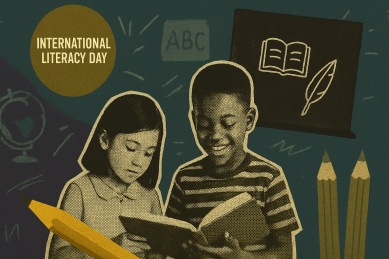International Literacy Day 2025 Today: Why is it celebrated on September 8 — history, theme and more
International Literacy Day 2025: The decision to set International Literacy Day on September 8 traces back to UNO and UNESCO conferences on education. The Tehran conference of 1965 unified international efforts toward eradication of illiteracy, marking a significant moment in global educational policy.

International Literacy Day 2025: International Literacy Day 2025 is globally celebrated today, September 8, recognised by countries around the world. The day marks a reflection on the importance of literacy, examines progress, and addresses persistent challenges. The choice of September 8 as its date has historic roots in UNESCO’s efforts to promote education as a universal human right, and its relevance remains undiminished in the current era, as many millions worldwide still lack basic reading and writing skills.
State-wise literacy rate in India 2025
International Literacy Day (ILD) is observed annually on September 8 and was proclaimed by UNESCO during the 14th General Conference in October 1966, following the landmark World Conference of Ministers of Education on the Eradication of Illiteracy held in Tehran in 1965.
The inaugural celebration on September 8, 1967, set the tone for decades of advocacy and action globally. Today, ILD is recognised by nearly every country in the world, from developed nations with high literacy rates to regions where illiteracy remains pervasive. UNESCO has documented participation by hundreds of countries and their commitment to promoting literacy as a fundamental right.
Why September 8?
The decision to set International Literacy Day on September 8 traces back to UNO and UNESCO conferences on education. The Tehran conference of 1965 unified international efforts toward the eradication of illiteracy, marking a significant moment in global educational policy.
UNESCO’s General Conference followed with the official proclamation in 1966, formalising September 8 as a day to remind the world of the power and necessity of literacy. This date was chosen for its symbolic value, representing the start of the academic year in many countries and setting a global rhythm for educational reflection and mobilisation.
UNESCO’s intent was not only to highlight literacy as a basic skill, but to make literacy a cornerstone of dignity, human rights, and global peace. Through recurring celebrations, September 8 became a day to mobilise governments, educators, and civil society in recognition of both ongoing progress and enduring gaps.
The roots of International Literacy Day also lie in UNESCO’s post-war mission to build peace through education, scientific advancement, and cultural exchange. With the Tehran conference acting as a catalyst, the official proclamation on October 26, 1966, and subsequent global observance in 1967, UNESCO positioned literacy as foundational to the Sustainable Development Goals, especially SDG4 — ‘Quality Education for All’.
Over the years, ILD has advanced diverse themes, from adult literacy and digital transformation to inclusion and gender equity.
International Literacy Day 2025: What is this year’s theme and significance?
For 2025, UNESCO has announced the theme “Promoting Literacy in the Digital Era” (as well as “Promoting Multilingual Education: Literacy for Mutual Understanding and Peace,” depending on the context).
This theme highlights the challenges and opportunities presented by digital transformation and the importance of integrating digital skills with traditional literacy. As digital technologies reshape communication, learning, and work, bridging the digital divide becomes central to those efforts.
The focus on multilingual education also calls attention to the role of diverse languages in inclusion, empowerment, and peace-building. Multilingual approaches are seen as especially beneficial for cognitive development and social cohesion, particularly among marginalised groups.
Shared September spirit of Teachers’ Day in India
Just days before International Literacy Day, India observes Teacher’s Day on September 5, commemorating Dr Sarvepalli Radhakrishnan’s birth anniversary. This celebration began in 1962. Dr Radhakrishnan, born on September 5, 1888, was a distinguished philosopher, the first Vice President, and the second President of independent India. He advocated that “teachers should be the best minds in the country,” elevating the role of educators as nation-builders.